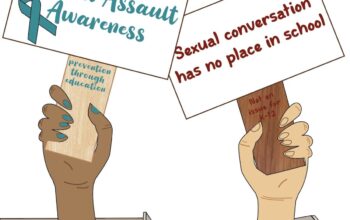Luka, sophomore
We all have come to know the spark that left middle-aged mothers to explain what a spanking bench is. We have all heard the snickering of 12 year olds, as they leaf through the pages of the erotic trilogy, Fifty Shades of Grey. Why the world has turned their eyes towards the story of Ana Steele and Christian Grey, is quite varied. While 50 Shades of Grey is an adult novel, everything about the marketing of this film — down to the choice of young actors and a soundtrack yielding a top-ten hit on the pop charts by Ellie Goulding and another song from Sia — points towards the intentions of reaching out to a younger audience. With this comes some issues, given that the intended audience is at most a couple of years away from college, where a terrifying rape culture presently exists. While I think that it’s great for the world to open up and talk about sexuality in the mainstream, I also think that the book and film glorify emotional manipulation, coercion, and sexual abuse– which is the romanticization of the all-too-real potential sexual horrors that the young audience may face in reality.
I saw the movie and was amazed by how watered down it was. There are 20 minutes total of pure sex in the film’s 100 minute running time, and during those 20 minutes I was thinking of how vanilla it was. Not at all as dark as the books had described it to be. One thing to be noted was that there was much more verbal consent and less coercion. Also, more communication on safe words, which is a thumbs up! But, there are still weird scenes. Christian doesn’t completely get out of his controlling grip when he enters the silver screen. He is still possessive and creepy, like when he takes Ana up to his hotel room (while she is disoriented) and starts to change her clothes. What strikes me as surprising is that people think that this is romantic. How is a dude making sexual advances on a wasted girl romantic? This is a realistic account of date rape, which is a thriving culture among college fraternities. If the film is in fact aimed towards youth, there is something troubling about the film illustrating situations like this as romantic when they might fall victim to rape culture themselves in only a matter of time.
Further in, the movie showcases more open communication, and although Grey still is pushy, he seems to have more respect than that of the book’s original writing. Ana goes along with it willingly, until the end when she has a change of heart. She asks “Why do you want to hurt me?” and right then and there you can see she doesn’t quite like it. She only ends up participating because he wants her to, not because she wants to. This is a portion of consent which is often overlooked: people can be coerced by more than just physical force. This once more proves true in actual date rape, which can occur without physical force.
At the end of the day people say, ‘Ah it’s just a movie’ and I completely agree. Yes, it is just a movie and it isn’t the first time that these issues have been brought into the limelight. But what happens when people boycott or shame others for seeing a film whose topics have been done before? I was told not to give money to see this film. The organizations against this movie say that “Hollywood doesn’t need your money, abused women do!” and that women in real life that deal with abusive relationships often don’t end up like Ana. They often seek help in shelters, on the run from possessive men, or just end up dead (according to the national center of sexual exploitation, in an interview with The Washington Times). The leaders of these organizations hope to offset the damage and glorification of the topics discussed.
But where were they in when Twilight hit theaters? Or how about The Hunger Games; I mean, that’s about killing children. Or how about Enough, with Jennifer Lopez which tells of one woman’s struggle to escape her manipulative boyfriend? 50 Shades of Grey as a film, and as a piece of art, does not answer to reality anecdotally (as the aforementioned films attempt in their own ways), rather it reflects reality as it is, and without any clear moral initiative.
The thing is that we pick and chose what to stand up for. The only reasons these organizations are acting now, is because there’s sex involved and its not something within a young adult fantasy section. These are REAL issues there are happening NOW and not in a vampire romance novel.
An effective solution to this would have been setting up stands so that after people have watched the movie they can see ‘Oh gee…yeah this is a real thing and could have taken another route for some people’, this way movie-watchers can enjoy a film and give money to those who need it.
It is all about choice and giving everybody a choice is always great…otherwise we become Christian Grey and tell people what to watch and what not to.




